#Metropolitan City of Rome
Explore tagged Tumblr posts
Text

Vicolo S. Lorenzo, Castel Madama, Lazio.
55 notes
·
View notes
Text

The Colosseum, Rome, Metropolitan City of Rome, Italy
Mike Swigunski
9 notes
·
View notes
Text

Young Herc
Roman statue of Hercules in his youth. Metropolitan Museum of Art, 1000 Fifth Avenue (at 82nd Street), Upper East Side, New York City.
21 notes
·
View notes
Text
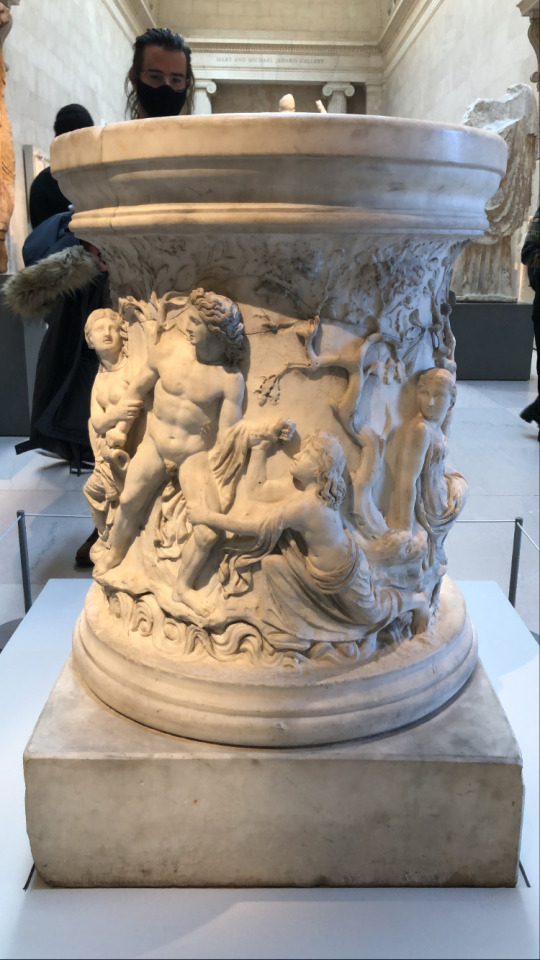
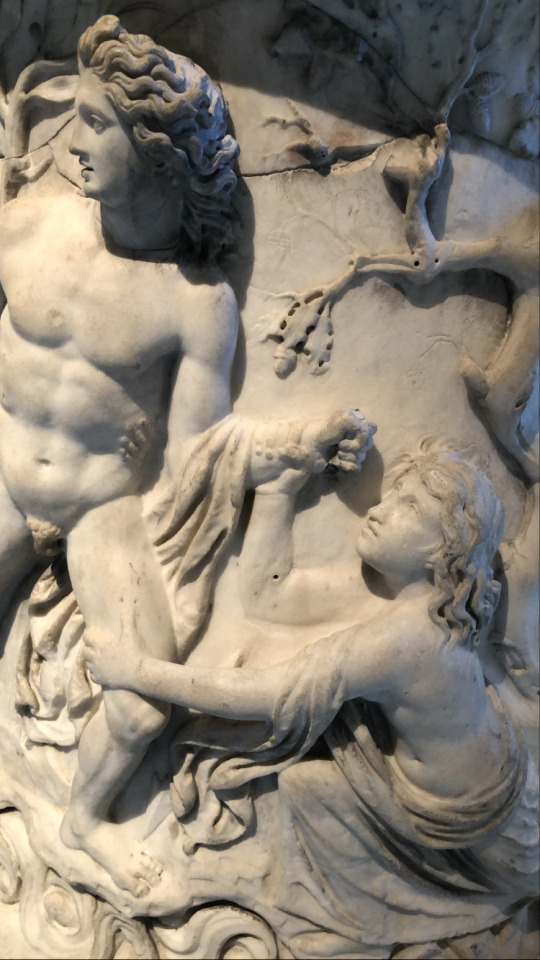
Puteal with Narcissus and Echo, and Hylas and the Nymphs.
Roman, Antonine or Severan, A.D. 150-200. Excavated in Ostia 1797, the port of Ancient Rome.
Metropolitan Museum of Art, New York.
#Roman art#Ancient Rome#ostia antica#the metropolitan museum of art#young and in love in new york city#new york#cool#art
5 notes
·
View notes
Text
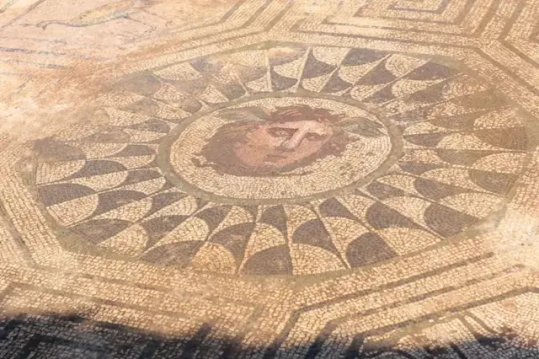
Archaeologists Unearth Ancient Mosaic of Winged Medusa in Spain
The stunningly preserved Ancient Roman mosaic floor was found at the Huerta de Otero site in the city of Mérida.
In both ancient and modern interpretations, Medusa is often known as a monster — a Gorgon with tresses of serpents whose stare turned men to stone. This version typically appears in children’s movies and fantasy thrillers, but her image hasn’t always been so awe-inspiring. In late June, archaeologists in Western Spain uncovered an Ancient Roman mosaic floor that depicts Medusa with tiny wings and flowing locks of hair, thought to have been used as a protective symbol.
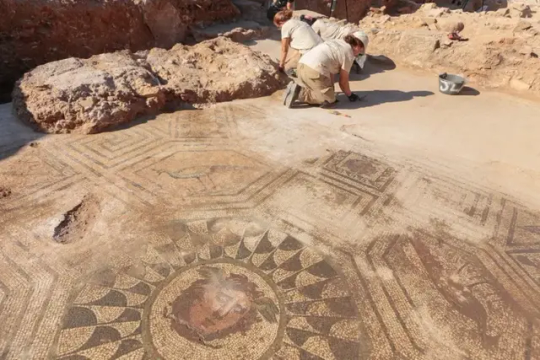
The mosaic was found in the city of Mérida’s Huerta de Otero archaeological site. Ancient Romans established a colony there in 25 BCE named Augusta Emerita. Traces of its former inhabitants — including an amphitheater and a bridge — can be found throughout the modern-day city. “[The site] is of an exceptional nature due to the level of conservation of the ruins and, above all, the ornamental elements that decorate the well-preserved house: not only the mosaic of the Medusa but also paintings and sculptural motifs,” said archaeologist Félix Palma in a statement.
The Huerta de Otero location was excavated in 1976 but lay untouched for decades. Research picked back up in 2019, when the city employed professional archaeologists and students from its Barraeca II Professional School to explore the ruins. Since then, the team has uncovered an Ancient Roman defensive wall, a road, and the home of a wealthy family.
The Medusa mosaic adorned the floor of this home. Depictions of fish, peacocks, and carefully tessellated patterns surround the artwork’s central figure: a human-like Medusa, her gaze turned to one side.

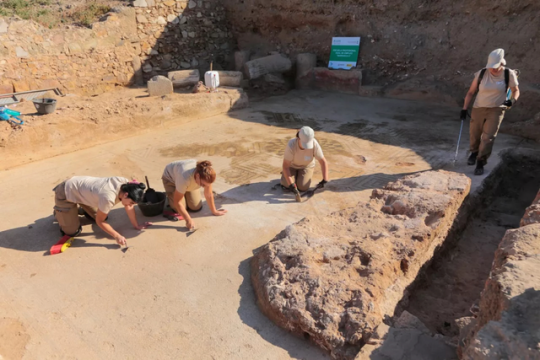
Although this image diverges from some contemporary renditions of the mythological figure, the mosaic’s winged version was common in Ancient portrayals of Medusa. While early Greek depictions of the mortal-turned-monster, cruelly punished for being raped by the god Poseidon, show her as grotesque, Medusa’s image softened by the time of the Ancient Romans. Beginning in the Classical Greek period, her face acquired more human attributes. It started to be rendered with symmetry and youthful beauty in the following centuries.
Other Ancient Roman mosaics featuring the head of Medusa have been discovered throughout Spain. Medusa again comprises the focal point of an Ancient Roman mosaic in a 115–150 CE work found in Rome, where she can be seen sporting human curls and a snake around her neck. A 1st-to-2nd-century ornament from a chariot pole shows a young woman with curly locks (although a couple of snakes still peer through her tangle of hair).
In Ancient Greek mythology, Perseus killed Medusa to avoid being turned to stone. Medusa, in her early terrifying form, was used as a protective symbol — “an image of evil to repel evil,” Madeleine Glennon writes in a 2017 essay for the Metropolitan Museum of Art. The goddess Athena famously included a representation of Medusa’s severed head on her protective cloak or aegis. In Ancient Rome, her beautified image was still employed as a protective symbol, although the depiction shifted into a form more similar to a woman than a monster.
By Elaine Velie.
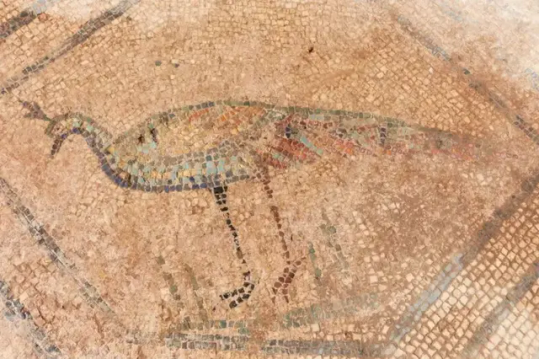

#Archaeologists Unearth Ancient Mosaic of Winged Medusa in Spain#mosaic#roman mosaic#Mérida Spain#Huerta de Otero archaeological site#ancient artifacts#archeology#archeolgst#history#history news#ancient history#ancient culture#ancient civilizations#roman history#roman empire#roman art
608 notes
·
View notes
Text
"Thousands of demonstrators converged opposite the White House on Saturday to call for an end to Israeli military action in Gaza, while children joined a pro-Palestinian march through central London as part of a global day of action against the longest and deadliest war between Israel and Palestinians in 75 years.
People in the U.S. capital held aloft signs questioning President Joe Biden’s viability as a presidential candidate because of his staunch support for Israel in the nearly 100-day war against Hamas. Some of the signs read: “No votes for Genocide Joe,” “Biden has blood on his hands” and “Let Gaza live.”
Vendors were also selling South African flags as protesters chanted slogans in support of the country whose accusations of genocide against Israel prompted the International Court of Justice in the Hague, Netherlands, to take up the case...
The plight of children in the Gaza Strip was the focus of the latest London march, symbolized by the appearance of Little Amal, a 3.5-meter (11.5-foot) puppet originally meant to highlight the suffering of Syrian refugees.
The puppet had become a human rights emblem during an 8,000-kilometer (4,970-mile) journey from the Turkish-Syrian border to Manchester in July 2001.
Nearly two-thirds of the 23,843 people killed during Israel’s campaign in Gaza have been women and children, according to the Health Ministry in the Hamas-run territory...
“On Saturday Amal walks for those most vulnerable and for their bravery and resilience,“ said Amir Nizar Zuabi, artistic director of The Walk Productions. “Amal is a child and a refugee and today in Gaza childhood is under attack, with an unfathomable number of children killed. Childhood itself is being targeted. That’s why we walk.”
London’s Metropolitan Police force said some 1,700 officers would be on duty for the march, including many from outside the capital...
The London march was one of several others being held in European cities including Paris, Rome, Milan and Dublin, where thousands also marched along the Irish capital’s main thoroughfare to protest Israel’s military operations in the Palestinian enclave.
Protesters waved Palestinian flags, held placards critical of the Irish, U.S. and Israeli governments and chanted, “Free, free Palestine.″
In Rome, hundreds of demonstrators descended on a boulevard near the famous Colosseum, with some carrying signs reading, “Stop Genocide.”
At one point during the protest, amid the din of sound effects mimicking exploding bombs, a number of demonstrators lied down in the street and pulled white sheets over themselves as if they were corpses, while others knelt beside them, their palms daubed in red paint.
Many hundreds of demonstrators gathered in Paris’ Republic square to set off on a march calling for an immediate cease-fire, an end to the war, a lifting of the blockade on Gaza and to impose sanctions on Israel. Marching protesters waved the Palestinian flag and held aloft placards and banners reading, “From Gaza to Paris. Resistance.”"
-via AP News, January 13, 2023
#sorry about the partial inaccuracy of the previous post#that was genuinely my bad and coming out of my own dismay at the underreporting of a lot of key events and milestones of the war#all the more reason I should have fact checked#palestine#free palestine#cw war#israel#ceasefire#gaza#palestinian genocide#protests#direct action#united states#washington dc#london#paris#rome#hope#good news
338 notes
·
View notes
Text




La chimera Alice Rohrwacher. 2023
Station 00051 Allumiere, Metropolitan City of Rome Capital, Italy See in map
See in imdb
#alice rohrwacher#la chimera#josh o'connor#carol duarte#station#italy#movie#cinema#film#location#hammer#chair#google maps#street view#2023#allumiere#lazio
167 notes
·
View notes
Text

Er Faciolaro, Italian restaurant, Rome, Italy : The restaurant "Er Faciolaro" is also a pizzeria open for lunch and dinner. Long-standing, rustic venue doling out Roman-style lamb dishes, pizza & seafood pasta... Rome is the capital city of Italy. It is also the capital of the Lazio region, the centre of the Metropolitan City of Rome Capital, and a special comune named Comune di Roma Capitale. Wikipedia
155 notes
·
View notes
Text

Allegory of Sacred and Profane Love
Artist: Michele Desubleo (Flemish, 1602–1676)
Date: 1665–1675
Medium: Oil on canvas
Collection: Metropolitan Museum of Art, New York City, NY, United States
Description
This painting is one of the supreme achievements of Michele Desubleo, a Flemish artist who trained in Rome alongside his stepbrother, Nicolas Régnier, before joining the workshop of Guido Reni. Desubleo combines Reni’s sensual depiction of the human form, citing his Sacred and Profane Love (Palazzo Spinola, Genoa), with a magnificent still life comprised of musical instruments, painter’s palette, fragments of sculpture, and armor that must have satisfied his learned humanist audience who - ideally, at least - balanced material pleasures with virtuous behavior.
#allegorical art#painting#oil on canvas#sacred and profane love#musical instruments#painter's palette#sculpture#armor#sescape#nude figures#trees#mountains#putti#male figure#laurel crown#cloth#clouds#michele desubleo#flemish painter#european art#artwork#17th century painting
38 notes
·
View notes
Text

Peter Hujar Fran Lebowitz 1975
"Rome is a very loony city in every respect. One needs but spend an hour or two there to realize that Fellini makes documentaries." Fran Lebowitz, "A World View" in "Metropolitan Life" 1978
55 notes
·
View notes
Text

Via Di Ripetta, Rome.
59 notes
·
View notes
Text






Rome, Metropolitan City of Rome, Italy
Cafer Mert Ceyhan
14 notes
·
View notes
Text

Dead Head
Marble funerary altar of Roman matron, ca. A.D. 90-100, Metropolitan Museum of Art, 82nd Street and Fifth Avenue, Upper East Side, New York City.
#museums#death rituals#funeral altar#ancient rome#roman matron#metropolitan museum of art#upper east side#new york city
23 notes
·
View notes
Text

The Sacrifice of Polyxena
Artist: Charles Le Brun (French, 1619–1690)
Date: 1647
Medium: Oil on canvas
Collection: Metropolitan Museum of Art, New York City, NY, United States
Description
As recounted by the ancient Roman poet Ovid, a compliant Polyxena is led to her death at a sacrificial altar to appease the ghost of the war hero Achilles. Le Brun painted this work the year after his return to Paris from studying in Rome and just a year prior to the founding of the French Royal Academy, which he would soon head. It captures the highbrow artistic ideals of seventeenth-century French academic painting: beautifully choreographed compositions that relay their narrative through a series of intense facial expressions and dramatic bodily gestures.
#mythological art#painting#oil on canvas#fine art#the sacrifice of polyxena#roman mythology#ovid's metamorphoses#literature#altar#male figures#female figures#mythological scene#charles le brun#french painter#french culture#17th century painting#city#mountains#horizon#clouds#nude characters#french art#artwork#european art
22 notes
·
View notes
Text

Oliva Ercolani (Olive) JJBA OC (more AU lore and world building)
Oliva is another Vento Aureo oc apart of my au. Her first name means "olive" in Italian. She enjoys chatting with new people and has a love for the arts. Oliva's birthday is July 25th and she's currently only 21. I will be drawing both a reference sheet for her and Pesche soon.

✨ STORY✨

💖 Oliva, the willful daughter of one of the most influential mafiosi in Italy, Giulio Ecrolani. She was raised in Florence Italy after the Ercolani family relocated there from Naples. She lived in Florence until the age of four. Then gained the opportunity to travel the world with her adoptive brother Pesche Mistro to study dance in different countries. During her years abroad at the age of 16, Oliva was given management of her very own international dance team.
She soon returned to Italy at the age 19 to put her newly acquired knowledge and skill set to good use. Two years later, Oliva now manages most of her father's theatre businesses within Florence. While also aiding the women in her community. She scouts talent, training them and the other women in the Ercolani family. So that they could eventually be employed at one of the many theatres/opera houses that her family own. However, trouble arrives when Oliva runs into her old friend Kimiko (they met abroad) who's now affiliated with Passione. Despite knowing about her family's hatred for Passione Oliva still communicates with Kimiko, keeping her friends affiliation with Passione a secret.

SOME INFO

💖 Oliva doesn't have a Stand. Though she is a very talented ballet dancer and is applauded for those abilities.
💖 Oliva travels between Naples and Florence often for work. She's both respected and well known amongst the women in both cities. She has a strong sense of justice especially when it comes to women in general.
💖 Despite her cute and unassuming appearance, Oliva's a clever woman with a fiery personality, very out spoken and head strong comparable to an Ox.

OUR RELATIONSHIP

💖 Oliva and I met while she was studying the arts abroad, mainly dancing. At the time, I was attending one of her dance classes that she was responsible for instructing. I wasn't the best at it and she offered one on one sessions. During that time we got closer and began hanging outside of her classes. Before long we developed a sort of sister bond. With Oliva taken the role as a sort of big sister role model. Nowadays I consider Oliva my best friend/family as she's the closest person to me besides Bruno.

INFO ABOUT THE ERCOLANI FAMILY

💖 A now powerful family, that had their humble beginnings in Southern Naples. In the beginning the Ercolani family had an arrangement with Passione. They had deep ties to the gang and agreed to work together since they both operated out of Southern Naples.
💖 The Ercolani would supply funding to Passione for a cut of the total profit made from the drug trade. But after finding out that Passione had been holding back on the family's cut, despite the investment, they had a huge falling out. Which led to a sort of heated rivalry. Eventually after a few years they cut ties and the Ercolani relocated elsewhere.
💖 They now own several major business throughout Italy. Mainly in tourism. They also have control of several popular opera houses in Florence and Rome. For now the two groups are at a sort of truce. Neither ventures on to each others territory. The Ercolani family has roughly 106 members and the head of the family is Giulio Ercolani. He is known for his intense hatred of Passione and love of opera.
-
(The family's name is a variation of Ercolano (Italian: [erkoˈlaːno]) is a town and comune in the Metropolitan City of Naples, Campania of Southern Italy. From the personal name Ercolano originally an adjectival derivative (meaning 'Herculean') of Hercules.)
#jjba oc#jjba original character#story writing#writing#jojo bizarre adventure#jjba vento auero#vento aureo#giorno giovanna#team bucciarati#jojos bizarre adventure#jojo fanart#jojo no kimyou na bouken#oc#original character#fan art#artist on tumblr#artist#yumeship#yumeship community#self shipping#self ship community#jjba part 5#jojo's bizarre adventure#jojo no kimyō na bōken#world building#fanfiction#self ship#fictional other#f/o#anime
14 notes
·
View notes
Text

Who Looted an Ancient Roman Shrine? A Village Finally Tells
Investigators say they have figured out how bronze statues from a shrine built 2,000 years ago in Asia Minor to venerate the emperors of Rome ended up in museums around the world.
One towering ancient bronze was found last year in the Sutton Place apartment of a notable New York philanthropist. Another this year in the Metropolitan Museum of Art. A third bronze, the head of a young Roman boy, was seized from Fordham University in March.
Each of these ancient artifacts, and a half dozen more like them, are believed to have once graced an elaborate shrine in a region that is now part of Turkey. Erected by locals to honor the Roman Empire at a time when it ruled that part of the world, the shrine in the ancient city of Bubon featured a pantheon of emperors, experts say.
So Lucius Verus, it’s thought, stood next to Marcus Aurelius, his adoptive brother with whom he ruled. The statue of Septimius Severus was beside those of his wife and children. The emperors Valerian and Commodus once stood on their own plinths nearby.

In 1994, a Turkish archaeologist, Jale Inan, published a book, “Latest Research on the Sebasteion of Bubon and Its Statues,” in which she plotted the location of the bronzes as they appeared in ancient times.
But just decades ago, according to investigators from the Turkish government and the Manhattan District Attorney’s Office, this set of rare, larger-than-life bronzes came to be scattered around the world. Individual statues ended up in a variety of affluent homes and prestigious museums.
Now, relying on newly discovered records and interviews with regretful, at times tearful, farmers now in their 70s, the investigators say they have been able to reconstruct what happened. They say men from a nearby village found the bronzes buried on a hillside, beginning in the late 1950s and, acting in tandem over a period of years, dug up the statues, often working in large groups to facilitate their excavation. Many were then sold to an antiquities dealer they knew as “American Bob.”
His real name, investigators say, was Robert Hecht and he would become famous — and later infamous — as one of the world’s great dealers of antiquities, both looted and unlooted. Although it had been illegal under Turkish law since 1906 to sell antiquities without official permission, Hecht and others brought the bronzes to market, the investigators say.

VALERIAN Roman emperor, A.D. 253 to 260 Headless torso is in the Burdur Archaeological Museum in Turkey. Head location is unknown.
Authorities now have begun to seize the bronzes, one by one. Two have already been returned to Turkey. Three more have been seized, and are yet to be sent back. Another four are being sought, according to the district attorney’s Antiquities Trafficking Unit.
Some experts, and at least one museum that holds a statue being sought, have questioned whether the evidence placing these particular artifacts in Bubon is as strong as the authorities have suggested. But Matthew Bogdanos, who leads the unit, said he is undeterred.
“Everybody fights Bubon,” he said of the naysayers. “But if there were ever a case we wanted to get into a courtroom, Bubon is it.”
The story of the Bubon bronzes, though, is more than just a tale of looters’ remorse, investigative zeal, art market intrigue and antiquities repatriation. It’s also a lesson in history, one that presents a more nuanced view of ancient Rome than that popularized by Hollywood epics. Those films often depicted an empire that relied almost exclusively on the spear, the whip and the executioner’s sword to keep the conquered in line. The truth was more complicated.
Some of the men who rose to lead Rome were, in fact, born in conquered lands. Severus was from modern-day Libya; the emperor Trajan from modern-day Spain. Rome allowed a measure of self-government and promoted the promise of citizenship as potent tools to keep the peace. And there was often local buy-in, evident in the shrines built by invaded peoples to show respect for their conquerors.
Known as shrines to the “imperial cult,” only a handful of them survive today in any form. One is the excavation at Bubon, according to archaeologists. From the time of Augustus, Roman emperors were venerated as gods, sometimes alongside the deities themselves. The shrine at Bubon, in what was then known as Asia Minor, is believed to have been built by local gentry as a sign of fealty to Rome. Started around A.D. 50, it is thought to have been in use for perhaps two centuries before it was buried in earthquakes.
The calamity, fortuitously, protected the bronze statuary at a time when discarded metal was routinely recycled into armaments. The Bubon bronzes, instead, remained underground, intact, for almost 2,000 years.
Until the farmers found them.

The stone plinths that made up the shrine bore the names of the Roman emperors, inscribed in Greek, with some of their imperial titles. This one once held a statue of the emperor Gordian.
Asia Minor Under the Empire
Though life under Roman rule would ultimately prove prosperous and pleasant for many of the people of Bubon, it took time and bloodshed.
Before the Roman conquest, parts of Asia Minor, also known as Anatolia, had embraced the Greek language and way of life and the region was largely under the dominion of Greek rulers for two centuries, starting with Alexander the Great in 330 B.C. But when Rome, after much warfare, ultimately took power in the first century B.C., the empire used its well-honed tactics to convert the region into a stable and passive province.
The Romans built paved roads and large public amenities like baths and markets. They integrated Roman tradesmen, soldiers and administrators into local life, and dangled the possibility of Roman citizenship, which conferred political rights on people from conquered lands.
“For much of Anatolia, the Roman Imperial period was the high point of classical antiquity,” said Peter Talloen, an archaeology professor from the University of Leuven in Belgium who is excavating in the region. “The vast road network built and maintained by Rome,” he added, “would result in Anatolian goods such as textile, pottery, wine and olive oil being profitably exported to all different areas of the Roman Empire.”
The Roman Empire, A.D. 200
In the period when the shrine at Bubon was active, the Roman Empire had spread through large parts of the world, as far west as modern day Britain and as far south as what is now Algeria, Libya and Egypt.

The Roman Empire, A.D. 200
In the period when the shrine at Bubon was active, the Roman Empire had spread through large parts of the world, as far west as modern day Britain and as far south as what is now Algeria, Libya and Egypt.
Bubon itself was a small and relatively wealthy agrarian hilltop community that, under Rome, featured central markets, a theater, low battlements and a small stadium for athletic contests. Its residents, perhaps a few thousand people, archaeologists estimate, would likely have enjoyed self-governance so long as they showed loyalty and paid tribute to the Roman prefect in charge of their province.
Amid the ruins of the theater, there is an inscription relating how the emperor Commodus (A.D. 177-192) commended the city for crushing a band of brigands. Bubon, as a result, the inscription reports, was rewarded with an extra vote at the provincial assembly.
Many monuments would have been erected, Talloen said, some to the local elites who financed the public buildings and activities like religious festivals, others to the Roman officials who authorized the local leaders to tax things like the ownership of land or the sale of produce.
The shrine, or sebasteion (suh-BASS-tay-ohn), at Bubon was one such monument, built to proclaim the populace’s devotion to Rome. Sakir Demirok, an archaeologist with the Burdur Museum in Turkey, said the shrine, a U-shaped courtyard that was probably covered, would have likely been a site for animal sacrifices, incense burning, and communal prayers and vows, led by a local priest.
Romans were keenly religious and worshiped multiple mythological deities, like Jupiter or Juno, whose favor or disfavor were thought to influence daily life.
“Rome was the safeguard of the peace and welfare,” Demirok said. “It was a system that provisioned grain for the citizens’ good and secured the trade routes. Cities were expected to demonstrate their gratitude for the stability provided by that system.”

“MARCUS AURELIUS” Roman emperor, A.D. 161 to 180 Headless torso at the Cleveland Museum of Art, under seizure order. Head location is unknown.
The Bubon shrine was begun, experts think, during the reign of Nero, between A.D. 54 and 68, and initially featured statues of the emperor and his wife Poppaea Sabina. Nero was popular in the Greek-speaking provinces because he embraced Greek culture and song. During its life span, at least 14 individuals were represented by statues — 11 emperors and three empresses — Demirok said, the last being Gallienus, who ruled from A.D. 260 to 268. As rulers were unseated, their statues were sometimes replaced, so Nero’s, for example, was removed and his name erased from the statue’s plinth, which later was used for Marcus Aurelius, experts said.
Experts credit the survival of the bronzes to a series of earthquakes that occurred in the decades after Gallienus was enshrined, burying the sebasteion in protective layers of soil and stone as the Roman Empire began its long decline.
The restitution of the statues now, as a group, serves to highlight, experts said, the central role they played in binding the people of a remote province like Bubon, spiritually and politically, to their counterparts in far-off Rome.
“They want to show their allegiance to Rome,” said Christina Kokkinia, an expert at the National Hellenic Research Foundation in Greece who has visited and written about Bubon. “They were proud to be Roman.”

Archaeologists and excavation site workers recreate the position of ancient bronzes of Roman emperors that once filled a shrine at Bubon in what is now modern Turkey.
Some Finds in the Fields
The looting of Bubon indeed took a village, investigators say.
The farmers from Ibecik, a small community a mile and a half from the shrine site, told interviewers that they had known about the ancient ruins for years before they began digging up the bronzes sometime in the late 1950s or early 1960s. As young men, they said, their teachers had led them up to a deep hole in the stony hillside that some came to call the “Museum.” One villager recalled some of the bronzes were piled up there, like logs in a fireplace, investigators said.
At first, just a few villagers were involved in selling off artifacts to local smugglers. But soon the local farmers joined in groups of 20 to 30 — sometimes cooperating, sometimes competing — to excavate and carry away the heavy, large bronzes, now filled with several centuries of settled dirt. Some statues were broken into pieces to make them easier to transport, the farmers recalled. Investigators say pickax marks are still visible on the bronze of Lucius Verus.
When the money came in, many of the families shared in the proceeds.
“It was seen as the property of the village,” said Zeynep Boz, a Turkish official responsible for the return of her country’s antiquities.
The illegal excavations ebbed after 1967 when the Turkish police found a headless bronze torso hidden in the local woods. That statue of Valerian, who ruled from A.D. 253 until his capture in battle with the Persians in A.D. 260, now stands in a museum in the nearby town of Burdur.

CARACALLA Roman emperor, A.D. 198 to 217 Head seized from the Met and in storage in New York. Torso is thought to be with a Greek collector.
But other bronzes, investigators say, had already entered the art market. Villagers recently recalled for investigators how a pair of local smugglers ferried the artifacts in a pickup truck to the port town of Izmir, about four hours away. There, in the souk, or bazaar, some were sold to a dealer they called American Bob. Investigators say that, based on the evidence they have collected, the dealer was Hecht.
The evidence includes shipping and sales invoices that show Hecht in possession of remarkable 2,000-year-old Roman bronzes that had never been seen before. In the late 1960s, he sold five — four torsos and a head — to a Boston collector called Charles Lipson, who exhibited them at several museums before consigning them to a New York gallery, from which they were resold. Investigators say Hecht sold other bronzes to a second gallery in New York.
At the time, the paper trail did not identify where the bronzes had come from and some of the statues had yet to carry the names of emperors. The bronze that was later identified as a depiction of Marcus Aurelius was just referred to as a large-scale Roman bronze in a 1974 museum exhibition, and there was a debate about where it and others had originated.
But a Turkish archaeologist, Jale Inan, came to be convinced they had all come from Bubon, which she visited in 1973, drawn by reports of the looting. In 1979, she traveled to Denmark, where a museum owned a bronze head that had been purchased from Hecht. She and a curator at the Danish museum agreed that it was likely a match for a headless torso in the United States that Lipson had owned and identified as that of Septimius Severus.

A line drawing featuring multiple boxes that depict the bases of statues that once stood in an ancient shrine. In her book, Jale Inan, the archaeologist, included schematic drawings of the site that depicted the scale of the shrine and were helpful in plotting the location of the bronzes.
In 1990, Inan returned to the hillside in Bubon to dig at the site. She spoke to local farmers who acknowledged they had taken part in illicit digging. She found a journal in which one of the looters had reconstructed what had occurred 30 years earlier. Through interviews and excavation, she plotted the positions of the statues using the stone bases that remained, the names of the emperors still inscribed on them in Greek.
In a paper and in a 1994 book, she cataloged her research, including sketches that showed how she thought some of the statues, now held by various parties around the world, would have fit onto the plinths at Bubon. She died in 2001, before she could realize the fruition of her efforts, but investigators today have built their work atop the research she started decades ago. “It was her life’s work,” said Elizabeth Marlowe, a professor at Colgate University in New York who has closely tracked the Bubon statues. “She began drawing attention to this problem shortly after the looting occurred and never gave up. She’s the one who connected the dots. This is all her work.”

A man walks on a road toward a rural town. In Ibecik, investigators are working with people from the village to reconstruct what happened decades ago when the bronzes were dug up.
The Farmers Came Forward
One summer afternoon in 2021, Zeynep Boz, the Turkish official, sat outside the village cafe in Ibecik’s main square and addressed some 90 farmers gathered at tables under the trees.
She described how, once Turkey adopted its antiquity law in 1906, there was no such thing as private ownership of buried antiquities. She assured the villagers they would not be prosecuted for events 60 years earlier and asked them for any old letters, photos or other evidence that could help get the statues back.
“Your village has been robbed to its bones,” she said. “It harms the country’s reputation. Please help me here.” “In the beginning they were like, ‘We don’t want to. The people have all died,’” Boz said in an interview. “But then slowly, slowly they understood our only purpose was making things good and they started talking to us.”
Boz and officials from the museum at Burdur eventually found 10 men who recalled the looting. Their testimony is crucial to Turkey’s repatriation claim, one now supported by New York investigators and other experts.
But not all experts agree that each of the statues was looted from Bubon. Some argue that Bubon was too much of a backwater to have housed such monumental bronzes or that the evidence is inconclusive.
Kokkinia of the National Hellenic Research Foundation said that, while she appreciates Inan’s research, she questions whether her archaeological techniques were sufficiently rigorous to have decided the question. She suggests further investigation at the site before every statue is shipped to Turkey.
“I love Bubon,” she said. “Let it have all the statues in the world. But it’s not necessarily scientifically correct in all cases.”
The Danish museum that for years said its bronze head belonged to the headless torso of Septimius Severus from Bubon has more recently said this is not certain. The Ny Carlsberg Glyptotek in Copenhagen said more research was required.

“SEPTIMIUS SEVERUS” Roman emperor, A.D. 193 to 211 Headless body seized from the Met museum. Returned to Turkey. Some experts say the head is at a Copenhagen museum, the Ny Carlsberg Glyptotek.
The Metropolitan Museum of Art in New York, where the headless “Severus” statue had been on loan, turned it over to the New York investigators for repatriation. But the museum said it was not established that it definitely depicted the emperor or had come from Bubon. While it had the bronze on display, the Met referred to it as simply “Statue of a Nude Male Figure.”
The Cleveland Museum of Art, which holds a headless statue that investigators say is the Marcus Aurelius that once stood in Bubon, has gone to court to block its seizure. The Manhattan District Attorney’s Office, which served seizure papers on the museum in August, said it has interviews and detailed forensic evidence that support Turkey’s claim. The museum has described the evidence as “conjecture,” though until recently it had said the bronze “likely represents Marcus Aurelius.” In recent months, curators have retitled the statue “Draped Male Figure.”
Some worry additionally that President Recep Tayyip Erdogan’s government may be aggressively exploiting the return of cultural property for political purposes, boosting a nostalgic Turkish nationalism and a reassertion of its historical greatness at a time when there are questions about its commitment to human rights and democracy. “Why is the U.S. rewarding Erdogan, a demagogue acting daily against U.S. interests in the region, for this bad action?” wrote Kate Fitz Gibbon of the Committee for Cultural Policy, in 2020.
But the New York investigators say they have recovered additional evidence that illustrates the scope of the looting at the shrine, including the Hecht invoices, the testimony of the villagers from Ibecik and arms and legs from bronze statues that may also be tied to the shrine. (Hecht, who died in 2012, was accused several times of antiquities trafficking but was never convicted.)
Several of the villagers have correctly identified the statues now being targeted as looted from a lineup of other ancient bronzes. Some have mimicked the poses of the bronzes for investigators to show they remembered what they looked like, investigators said.
“There is this unbelievable heartening thing happening where people are coming forward in their 70s and saying, I have been living with this for 55 years,” Bogdanos of the district attorney’s office said.
Earlier this year, when the statues of Septimius Severus and Lucius Verus were returned, two of the looters, now in their 70s, were invited to see them.
“They were very emotional,” Boz said. “They really regret it. You can see it in their eyes.”
By Graham Bowley and Tom Mashberg.

#Who Looted an Ancient Roman Shrine? A Village Finally Tells#ancient city of Bubon#ancient roman shrine#ancient roman temple#roman bronze statues#stolen art#looted art#ancient artifacts#archeology#history#history news#ancient history#ancient culture#ancient civilizations#roman history#roman empire#roman emperor#roman art#ancient art#long post#long reads
38 notes
·
View notes